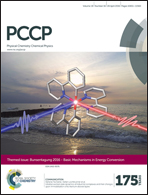Influence of the protonation of pyridine nitrogen on pnicogen bonding: competition and cooperativity†
Abstract
Ab initio MP2/aug-cc-pVTZ calculations were performed to investigate the pnicogen-bonded complexes of PyZX2 (Py = pyridine, Z = P and As, X = H and F) and their protonated analogues. The selected Lewis bases include H2S, PH3, H2O, NH3, and H2CO. The relative stability of pnicogen-bonded complexes is related to the nature of PyZX2 and bases. When the nitrogen atom of the pyridine ring in PyZX2 is protonated, the protonated complexes are more stabilized than their neutral counterparts, with the interaction energies increased by 8.5–34.6 kJ mol−1 and the binding distances shortened by 0.050–0.574 Å. Protonation strengthens the pnicogen bond, from a weak interaction to one of moderate strength. In the neutral complexes of PyZX2 and H2O, the formation of a N⋯H–O hydrogen bond is favorable compared to the pnicogen bond. Such inclination is more prominent in the complexes of protonated PyZX2 and NH3. In H2O⋯PyZX2⋯H2O, pnicogen bonding is strengthened by hydrogen bonding due to positive synergistic effects; however, in NH3⋯H+-PyZX2⋯NH3, pnicogen bonding is weakened by hydrogen bonding due to negative synergistic effects.


 Please wait while we load your content...
Please wait while we load your content...